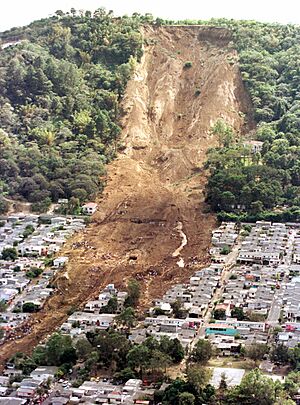January 2001 El Salvador earthquake facts for kids
| UTC time | 2001-01-13 17:33:32 |
|---|---|
| ISC event | 1763440 |
| USGS-ANSS | ComCat |
| Local date | January 13, 2001 |
| Local time | 11:33 |
| Magnitude | 7.7–7.9 Mw |
| Depth | 60 kilometres (37 mi) |
| Epicenter | 13°02′N 88°40′W / 13.04°N 88.66°W |
| Type | Normal |
| Areas affected | El Salvador Guatemala |
| Max. intensity | VIII (Severe) |
| Casualties |
|
The January 2001 El Salvador earthquake was a very strong earthquake that hit El Salvador on January 13, 2001, at 11:33 AM local time. It was a powerful quake, measured at about 7.7 on the Moment Magnitude scale. The earthquake's center was deep underground, about 60 kilometers (37 miles) below the surface, southwest of San Miguel, El Salvador. This natural disaster caused a lot of damage and affected many people in El Salvador and even in neighboring Guatemala.
Contents
What Happened After the Quake?

The earthquake caused a lot of destruction. In El Salvador, at least 944 people died and 5,565 others were hurt. Many homes were destroyed or damaged. More than 108,000 houses collapsed, and another 169,000 were damaged.
A big problem after the quake was landslides. About 585 of the deaths were caused by huge landslides in places like Santa Tecla and Comasagua. Landslides often cause a lot of damage after earthquakes in El Salvador.
Damage and injuries happened in every part of El Salvador. The areas of La Libertad and Usulután were hit especially hard. Eight people also died in Guatemala. People felt the shaking from as far away as Mexico City to Colombia.
Two days later, on January 15, a strong aftershock of 5.7 magnitude hit. Aftershocks are smaller earthquakes that happen after a big one. More than 2,500 aftershocks hit El Salvador by early February, causing more damage and making people very scared.
After the earthquake, getting clean water and good sanitation became a big worry. The earthquake damaged water systems, costing millions of dollars. Many thousands of people had to live outside. Public health groups warned about diseases spreading because of the lack of clean water and damaged areas.
Why Do Earthquakes Happen Here?
El Salvador is located in a place where two huge pieces of the Earth's crust, called tectonic plates, are moving towards each other. This area is called a convergent boundary. Here, the Cocos Plate (an oceanic plate) is slowly sliding underneath the Caribbean Plate (where El Salvador sits). This process is called subduction.
This movement causes earthquakes. Some earthquakes happen right where the plates meet. Others happen within the plates themselves as they bend and break.
The January 13 Earthquake
The earthquake on January 13, 2001, happened because of a "normal fault" within the Cocos Plate as it was sliding down. This means the ground moved in a specific way deep underground. Scientists looked at the earthquake's depth and how the ground moved to figure this out.
After the main earthquake, there were many aftershocks. By February 2, 2020, 70 aftershocks were stronger than magnitude 4, and 10 of those were stronger than magnitude 5. The biggest aftershock was a 5.8 magnitude quake on January 15.
Exactly one month after this earthquake, another destructive earthquake hit El Salvador. However, this second quake happened on a completely different fault line within the Caribbean Plate. It caused another 315 deaths.
See also
- 1986 San Salvador earthquake
- List of earthquakes in 2001
- List of earthquakes in El Salvador



